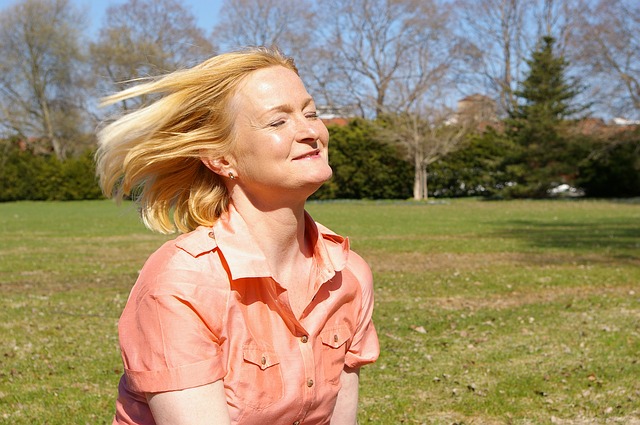
01 Mar Mood Swings During Perimenopause: De-stressing the Natural Way
Folks can go into menopause after not having their period for about 12 months. The years leading up to menopause are termed as perimenopause. For the duration of perimenopause, many begin to notice their periods turning out to be irregular. Your menstrual flow may be lengthier or shorter than it was before. It may also get heavier or lighter. These fluctuations are initiated chiefly by fluctuating estrogen and progesterone levels as your body arranges itself for menopause, which will consist of no periods. Estrogen and progesterone are hormones that aid to control and manage the reproductive system.
Many can experience further discomfort for the duration of both perimenopause and menopause. These symptoms may consist of:
- Hot flashes
- Vaginal dryness
- Reduced sex drive
- Difficulty in sleeping
- Mood swings
Mood can be influenced by a lot of seemingly trivial things, from a disagreement with a loved one to a frustrating traffic jam. It is not always understood what triggers mood swings and the bad temper that frequently go together with them. Mood swings are also different from depression, which is not characteristically related to menopause.
Home treatments
You may be able to lessen or reduce mood swings by making positive lifestyle alterations, including adding quality supplements to your health regimen.
Cardio workouts
Try to incorporate 50 minutes of aerobic workout or exercise that includes circular breathing and various other forms of workouts four times a week. Being consistent can lessen numerous menopausal symptoms; including night sweats, crankiness, and mood swings. Working out and physical activity in general can discharge endorphins and other feel-good chemicals in the brain. Select the time of day you are most probable to stick to a schedule and select the workouts or activities you find most enjoyable. You may wish to switch up your exercises. Attempt running one day and swimming the subsequent day, or go cycling every alternate day. You do not require to train like an Olympian to get mood-enhancing outcomes. Taking a brisk walk right before work or after dinner may be just as powerful on lessening mood swings as preparing for a marathon.
Eat healthy food
Consuming healthy foods could be just as great for your mood as it is for your body. You may merely feel a lot better after consuming a protein-rich salad than you would after eating processed or sugary foods. A diet consisting of healthy foods such as fruits, vegetables, lean protein, and whole grains will provide essential vitamins. Foods rich in omega-3 fatty acids, folate, and other nutrients may also help enhance your mood.
Let go of stress
De-stressing may be as simple as losing yourself in a page-turning thriller novel. For others, mild yoga, meditation, or comfortable walks in nature may assist in improving mood and lessen apprehension and anxiety. Think about trying deep breathing meditation or yoga poses that purify your mind or feel like a small vacation.
Get sufficient sleep
Not getting sufficient sleep can lead to additional crankiness and mood swings. Make a night time schedule that allows you to leisurely drift off to sleep. Shutting off electronic devices, making certain your room is sufficiently cool in temperature, and getting rid of ambient light may help. Not consuming caffeine and alcohol before bed can also aid you to maintain and uphold healthy sleep cycles. Sleep should last 7 to 8 hours to permit healing and repair of immune function.
Yoga and meditation
Yoga and meditation can assist in getting rid of touchiness and nervousness brought on by menopause. An incorporated tactic of yoga therapy aids in treating symptoms such as hot flushes and night sweats. Yoga relaxation and stretching exercises help in alleviating mood swings while improving general well-being.
Ginseng
Ginseng is one of the most prevalent medicinal herbs. It has healing health advantages and is helpful in getting rid of menopausal symptoms of anxiety, cognitive impairments, vaginal dryness, depression, lethargy and apprehension for the reason that it is thought to be an “energizer” and a “normalizer.” It assists in improving mood and sleep and can be consumed in various forms that include tea, powder, and extract.
St. John’s Wort
It is a flowering plant of the genus Hypericum and is also known as Hypericum perforatum. It has been utilized as a medicinal herb for its anti-inflammatory effects and antidepressant properties for more than 2,000 years. St. John’s wort is most widely used to naturally ease depression and symptoms such as lethargy, stress, reduction in appetite, and difficulty in sleeping. It is a substitutive treatment for menopausal mood swings and lessens anxiety and depression.
Maca Root
Maca has been used for thousands of years to reduce the effects of anxiety, stress, and aging on the body by alleviating cortisol levels. It helps in reducing hot flashes, restlessness, low energy/fatigue, and weight gain while improving both energy and libido.
Red Clover
Red clover regulates hot flashes, treats breast pain or tenderness (mastalgia), eases premenstrual syndrome (PMS), and increases bone mineral density. Red clover consists of isoflavones which have positive effects in reducing symptoms linked to a reduction in estrogen levels such as hot flashes, weight gain, troubled sleep, bone loss, fracture or osteoporosis, heart diseases, and inflammation of the joints. Isoflavones occurring in red clover extract also relieve symptoms of depression and anxiety.
Black Cohosh
Black cohosh aids in preventing menopausal symptoms that include night sweats and hot flashes. It assists in improving quality of sleep, relieving hormonal imbalances linked to fibroids or diabetes, and even helps with fertility prior to perimenopause and menopause.
Avoid foods that make menopause worse
These consist of packaged and processed foods, meat, added sugars, processed oils, fried foods, carbonated drinks, and alcohol.
